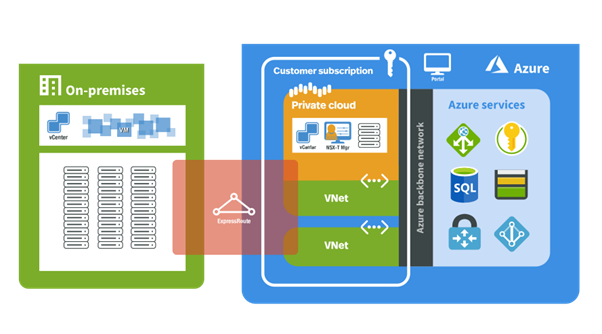Having the ability to run VMware virtual machines on Microsoft Azure brings many cloud benefits to the mainstream, while being overlooked by cloud-native purists. It’s a question of perspective and, as with most things in life, different people have differing views. Here’s my view on why the new Azure VMware Solution is great news for many.
We’re going to put ourselves in the shoes of a mid-size organisation that predominantly runs VMware virtualised workloads but also has some applications delivered via SaaS. The organisation has a small infrastructure team looking after the VMware estate, amongst other things. They have been facing pressures over the years around digital transformation and cloud-first strategies and compounding that, COVID-19 has elevated the agility, scalability and accessibility advantages of cloud-based apps.
Up until now the only option to get to the cloud, when SaaS is not available, has been to migrate workloads and data to native cloud services and change existing tools, skills and processes to be able to secure, operate and optimise the new cloud landscape - or more likely - look for a managed service provider to do all that (cue a blatant plug for Logicalis managed Azure services). Many mid-sized organisations procrastinate here, waiting for the complexity, risk or disruption of undertaking a cloud migration to reduce.
What Azure VMware Solution brings is the ability to transition to cloud, instead of transforming to it. Azure VMware Solution runs VMware’s Cloud Foundation technologies on top of Azure bare metal services, so it acts and looks like a VMware data centre except that…
- Licences - no need to buy any VMware licences, they are included, meaning VMware licence costs can reduce once some apps have migrated across.
- Technology - no need to burn cycles on choosing/designing/deploying/managing/supporting/maintaining/refreshing the underlying infrastructure or VMware technologies, Microsoft does it all.
- Lead time - Azure VMware Solution is ready in hours, not weeks or months, from the point of ordering – both for the initial cluster and for any ongoing scaling up or down – Microsoft automates the whole process, increasing agility.
- Billing - the environment is billed monthly on a consumption basis, so costs can vary as the environment is scaled up or down.
- Tools - no need to stop using existing VMware tools to manage the environment but the Azure tools are also there to try out, from the Azure Portal for administration to Azure Backup.
- Azure services - Azure VMware Solution has direct access to all of the Azure services, so app teams can start to trial transforming some app tiers, at little risk and little cost.
- Committed spend - this service counts towards any spend commit with Microsoft.
 [image: Azure VMware Solution Overview, source: Microsoft.com]
[image: Azure VMware Solution Overview, source: Microsoft.com]
So Azure VMware Solution gives us what we’d expect from any standard VMware environment, plus all the benefits of being an Azure service. This means we can migrate existing workloads and data to cloud quickly with minimal disruption and a minimal learning curve. App teams can then start to transform those apps when budgets and resources align, and we can reduce the Azure VMware Solution footprint. So, if your infrastructure teams are ready to move to cloud or need to evacuate a data centre but your app teams are not ready yet, this is a great solution.
If we were a VMware user but are not looking to migrate to the cloud right now, Azure VMware Solution provides benefits for other use cases too.
The obvious case is cloud-based disaster recovery. We could avoid the need to invest in a second data centre facility, duplicate infrastructure and VMware assets and use the cloud for DR. When not in use, the cluster can be shrunk to the minimum size and used for activities like test and development.
Then we have capacity augmentation and bursting. Azure VMware Solution is an elastic service that can grow and shrink, so is useful for scaling up to augment capacity shortcomings in the data centre and then scaling down when capacity is no longer an issue. Workloads and data can be moved between locations using standard vMotion features.
That’s about it. From the perspective of a mid-sized organisation with a small infrastructure team, Azure VMware Solution shouldn’t be overlooked as a valid step on a cloud journey. It enables migration to the cloud at an infrastructure level, without disrupting application or operations teams. From there it enables low risk app transformation to Azure services. What’s not to like?
To explore if AVS is right for your cloud journey, get in touch or register for our forthcoming 30-minute online masterclass, Azure VMware Solution: Three use cases that deliver a competitive advantage.
Article originally published by Neil Thurston Chief Technologist @Logicalis UK | driving digital success with technology | public & hybrid cloud | modernised data centre | AIOps & intelligent automation


